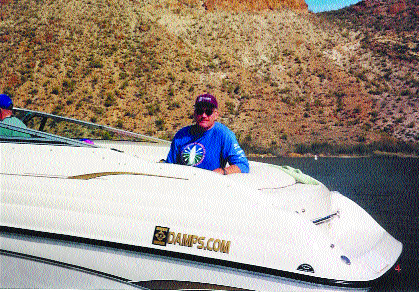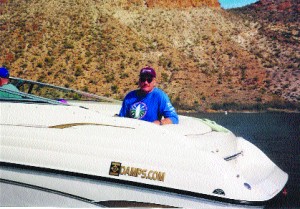By Mike Pincher
How would you like to hike 20 miles and feel like you only hiked two? Well, if you were wearing SEMS (Soldier Enhanced Military Systems) Smart Boots like our Army Special Operations Forces will be doing this year, thanks to an arrangement between the U.S. Special Operations Command and B&B Technologies LP, that’s the comfort level you would have.
This is due to Directional Axial Magnetic Propulsion Systems (DAMPS) technology. Its inventor, Jeffrey W. Brown, is CEO of B&B, located in San Diego, Calif., and Mesa, Ariz., which has managed Advanced Footwear Technology R&D since 1988. To date, 70 limited partnership investors are part of a DAMPS I Limited Partnership that secures B&B’s patented technology (in compliance with Reg D, Rule 506, the number of unaccredited investors for this No Cap partnership does not exceed 35).
Not to be confused with magnetic insoles, Brown explains the principle behind the shock mitigation and propulsion of his technology.
“DAMPS shock mitigation is generated with an engineering combination of opposing super magnets, an array of stainless steel compression springs, design flexure of the inner parts infrastructure and the high resilient proprietary formulation outsole,” Brown said. “These engineering elements work together to allow for a mechanical deflection for the foot of up to five-eighth inches without ever coming to a solid.”
The five-eighth inches is an air gap in the outsole that prevents kinetic friction heat buildup that victimizes conventional outsoles. Instead of the 10 percent shock mitigation as in current boots, Smart Boots enjoy 45 to 90 percent, depending on terrain and the weight borne by the wearer. For SOF, that weight includes a rucksack and equipment of up to 110 pounds.
“With DAMPS, the wearer is in dynamic kinetic load suspension in normal biomechanic activities, versus limited resilience composite material outsole without DAMPS,” Brown said.
So how is the propulsion itself produced?
“Real time, magnetic mechanical propulsion is attained as the DAMPS technology is loaded in normal motion gait, and goes into suspension on heel strike impact,” Brown explained. “As the foot moves beyond heel strike and rolls forward in motion gait to the ball and the toe, the DAMPS system releases stored mechanical energy propulsion as the magnets, springs and materials return force to their unloaded position.”
The inventor’s main motivation comes from a direct personal experience. In 1988, he was in a motorcycle accident that broke his foot, knee and ribs. He was in rehab for over a year and during that time, he and his brother arrived at the idea for magnets in shoes. One of his main consultants was Dr. John Ciccone, who was his treating podiatrist and is now a part of DAMPS I LP.
“Dr. Ciccone taught me almost everything I know regarding biomechanics and the dynamics of the foot,” recounts Brown.
It took nine prototypes and 14 years of privately financed R&D to arrive “on the cusp of changing footwear history.” NASA’s contribution to this process?
“Rapid prototyping,” he says. “With CAD/CAE, the development time to 3D part proofing is quickened. A designer can proof parts and designs in 3D that before required manufactured tooling. Rapid prototyping, developed as a byproduct of the NASA technology expansion revolution of going to the moon, has allowed DAMPS technology to be produced in 3D prototypes. This enables a CEO to further the concept, raise more money, show progress, etc.”
“Rapid prototyping” has also been called tool-less manufacturing, automated fabrication, free-form fabrication and desktop manufacturing, and has been applied to numerous other industrial platforms, including ceramic and plastic designing and other engineering and industrial enterprises.
While arrangements between NASA and small businesses can take many forms, in this case, for B&B’s rapid prototyping access and as part of a promotional exchange partnership to boost viewership, Brown and NASA tech briefs have exchanged banner site links.
Brown, born in Montrose, Colo., graduated from Palm Springs High School in California with a 3.84 GPA and earned his bachelor of science in business marketing in 1977 at San Diego State University, “back when marketing was born.”
He is not alone in trumpeting DAMPS’s technological virtues. Bill Walton, former UCLA basketball great (NCAA Player of the Year from 1972-74) and NBA Hall of Famer (MVP in 1978; NBA titles with the Portland Trailblazers in 1977 and the Boston Celtics in 1986) also does. Walton is an executive senior member of DAMPS I LP Advisory Board and does an audio introduction of the technology at DAMPS website.
“A longtime friend of the family, Mike Florio, who is also our family chiropractor, had told me about Jeff,” he said. “I went to the DAMPS website and was very much impressed by what he was presenting and offering in footwear technology. I set up a meeting at my house to talk further. After meeting with Jeff and seeing his enthusiasm and overall knowledge, as well as seeing the prototypes and experiencing the super magnets first hand, it was an easy decision to want to be involved with the future of footwear technology.”
He sees the SOF transaction as the springboard for future public consumer footwear development.
“The ongoing results of our military field testing will present us with a biomechanic data base that includes extensive figures for reduced injury trauma, wearer wellness, increased productivity and performance,” Walton declared. “Extrapolating this enhanced performance information will be our calling card for introduction into the commercial work markets.”
Once this data has been gathered, the results will speak for themselves in the commercial setting.
“Anyone on their feet all day long will experience the benefits of advanced shock mitigation,” the current ABC and ESPN basketball announcer said. “As I mention in my audio introduction on the DAMPS website, low back problems are the number two cause of employee downtime (behind the common cold), and DAMPS is the twenty-first century answer to them. The great thing about it is that the wearer doesn’t have to know anything about kinesiology or biomechanics to experience the benefits. You can feel the difference each and every step.”
Other prospective military applications for DAMPS beyond footwear include shock mitigation for Navy ocean assault vessels for high gravity episodes of 16 through 20 Gs. Additional public arenas are also targeted.
“We have done some very initial football helmet, bike seat and bike and motorcycle fork shock reduction design work via think tank discussions,” Brown said. “There will be more research and development in those areas after boot prototype development.”
Brown said he would like to partner with GM for advanced magnetic suspension/propulsion development.
“We would like to include them as a strategic alliance partner in our upcoming private offering to further the technology and will be approaching them in the very near future,” he said.
Besides the added safety to the vehicle, a further beneficiary of DAMPS technology would be the battery, which could receive supplemental power in the process.
“Any system that utilizes opposing magnets in a suspension/propulsion application will also generate DC electric current as a byproduct,” he said.
“How that DC is directed is a different engineering that can be utilized to add power to batteries and/or power to auxiliary electronic devices.”
Football fans and players are well aware of how hard (and hence, unpleasant and sometimes injurious)
Astroturf playing surfaces are for the participants. Brown addresses this as well, saying they would like to license DAMPS technology to the NFL.
“We have proposed to the NFL a thin slice of our material under Astroturf to add resilient cushioning to the concrete floor,” he said.
Brown can personally relate to sports. In high school, he participated in varsity track (miler). At SDSU, he was on the varsity rowing crew. In 1987, he was a California State Outrigger Canoe Champion. Even at 48, he still places a premium on physical conditioning, working out six days a week—three days weight training, two days swimming 50 laps and one day biking seven to 10 miles. He also does 150 vertical sit-ups, with gravity boots, and 100 push-ups every day, as well as 4,000 ab crunches per week!
As one might suspect, Brown is no ivory tower theoretical scientist who works only on raw data. His own various physical activities have paid dividends in helping him conceptualize his technology.
“I used to ride motocross in the deserts of Palm Springs in the early 1970s,” he noted. “Steve McQueen used to ride in our same area. He would come down from the mountain, wearing his white T-shirt and Bell helmet, and kicking up loads of dust, his Huskavarna 400 piercing the desert quiet. At that time, the best shocks had maybe three to four inches travel distance.
Today’s dirt bikes have 10 to 14 inches. What did that teach me? You get shock mitigation by adding time (as travel length) to the load force distribution equation. The benefits of magnetic dampening are that there are no seals to wear out, no fluids and the system is lifetime permanent. Plus, every bump, every rut, allows the magnets to also create DC current.”
While the motorcycle accident in 1988 was the main catalyst for DAMPS development, his earlier rowing experience planted a seed in that direction as well.
“When I was crewing for SDSU and paddling outrigger canoes, for me the biggest pain was in the seat,” he grimaced. “After a grueling 5 a.m. to 7 a.m. workout in an eight-man shell, or 20 miles in a six-man ocean canoe, the pressure on the posterior becomes tremendous. That experience made me think that something ought to be done toward mitigating that discomfort, even though the accident itself was the clincher toward pursuing my technology.”
The B&B CEO also looks forward to DAMPS application to aircraft to promote overall safety.
“I would begin with the seats to give better suspension, and then look at every interior system that could benefit from shock mitigation and power generation,” he said. “The exterior landing gear would seem an obvious choice for shock reduction. The tremendous direct load Gs will be challenging.”
He also reported that as with every successful enterprise, it has been a team effort from the very beginning.
“I have a crack team of eight equity-based managerial assistants who have championed this technology for some time now,” he said. “Two of them are footwear experts with over 30 years in the industry.”
Besides the benefits garnered from rapid prototyping, Jeff Brown is greatly appreciative of the identity enhancement impact of his affiliation with NASA.
“In a business start up mode, a small business entity’s affiliation with a name such as NASA adds a needed recognizable accreditation,” he said. “It adds what I believe is a needed boost for small businesses and entrepreneurs everywhere.”
Jeff Brown invites further questions and comments about DAMPS to be directed to him at ceo@damps.com. For more information, visit [http://www.damps.com].













